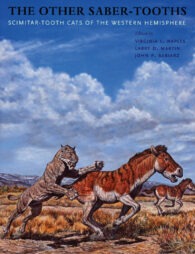Edited by Virginia L Naples, Larry D Martin and John P Babiarz
This review was written by Wilrie van Logchem and Sir Dick Mol of the Netherlands.

This beautiful, richly illustrated book was published by a group of sabre-tooth experts. It describes, in detail, the osteology of Xenosmilus and all skeletal elements are depicted in great detail.
In the 1990s, in 1.2myr-old sediments in Florida (USA), two, almost complete skeletons of a sabre-tooth cat were discovered. One of the skeletons ended up in the Natural History Museum of Gainesville and the other in the collection of BIOPSI (Babiarz Institute of Paleontological Studies, Incorporated), which is led by John P Babiarz from Mesa, Arizona.
Initially, the two skeletons, including the complete skull with mandible, were ascribed to a Homotherium. However, while prepping the skull, John Babiarz noticed that there were a lot of differences in comparison to the other sabre-tooth cats. John is pre-eminently a specialist in fossil cats and, in his collection, he has over 300 skulls from all sorts of sabre-tooth cats, ascribed to 19 genera and 38 different species. After some intensive discussions with Larry Martin from Lawrence, Kansas, it soon became clear that they were dealing with a Homotherium with features of Smilodon. Further studies led to the conclusion that this Early-Pleistocene, North American cat is a justifiable new genus and species
Smilodon is the best known sabre-tooth by the layman and experts, particularly in North America (if only for those who saw the movies Ice Age I, II and III).They are especially well known from the tar pits of Rancho La Brea near Los Angeles in California. In Europe, the sabre-tooth cats are from the genera Megantereon and Homotherium. However, Xenosmilus is smaller than the average Homotherium (110cm at the shoulder) and has a more powerful body.
Therefore, Xenosmilus is a prowler and the Homotherium is more of a runner. For the first time, we find in this book a detailed description of these wonderful animals, with illustrations of all skeletal elements. These are of great value for all of those who are interested in recognising the bones of sabre-tooth cats, but also other cats in general. In The Other Saber-tooths: Scimitar tooth cats of the Western Hemisphere, the illustrations are of such an unprecedented quality and show (along with the rest of the new results presented in this book) that many years of pain-staking work have preceded this publication. For example, there is an extensive chapter on the muscle structure of the Xenosmilus and this is beautifully visualised in this richly illustrated book.
And, in the book (also in great detail and illustrated), the species Homotherium ischyrus is described for the first time. It concerns again an almost complete skeleton, which was found in the State of Idaho and is of Late-Pliocene age. In a very extensive chapter about this Homotherium, the authors compared it with Homotherium crenatidens from Europe and the Homotherium serus from the Late-Pleistocene of North America.
It definitely not our intention to discuss in detail every chapter of this book. However, its 236 pages give so much clear and useful information that we can recommend it to you. One of its authors, John Babiarz (with whom we have had many years of intensive contact and cooperation), has worked over 12 years on this publication, which finally saw the daylight by the generous commitment of several different experts, who contributed to the realisation of this unique book. The page-sized colour illustrations of different sabre-tooth cats, which brighten up the book, alongside the amazing black and white illustrations of the skeletal elements, are by the world-renowned artist Mark Hawlett. And almost all of the illustrations of the bones are by Mary Tanner.
Finally, for those who are interested in sabre-tooth cats and, therefore, are aware of the existence of Homotherium latidens from the Late-Pleistocene from the North Sea floor, it is interesting to know that this mandible was used in the investigation of Xenosmilus and Homotherium from Florida and Idaho respectively. The Netherlands does count in the world of mammalian Palaeontology. Indeed, that important mandible is pictured twice in this outstanding book. Yes, in a book about those other sabre-tooths.
The Other Saber-tooths: Scimitar tooth cats of the Western Hemisphere edited, by Virginia L Naples, Larry D Martin and John P Babiarz, The John Hopkins University Press, Baltimore (2011), 236 pages, (hardback), ISBN 9780801896644


